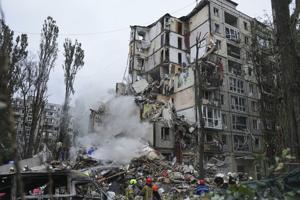A major metropolitan area recently experienced a devastating large-scale incident, resulting in significant loss of life and widespread destruction across its urban landscape. Authorities reported a substantial number of casualties, including adults and several children, as the capital city became the primary target of an unforeseen aerial event. Emergency services were immediately mobilized, navigating through extensive damage to reach affected citizens and provide urgent assistance, highlighting the critical nature of an effective emergency response in such widespread crises.
The human toll of this tragic event has been profound, with reports confirming multiple fatalities and over a hundred individuals sustaining injuries of varying severity. Among those critically affected were several young children, including infants, making this one of the most impactful incidents on vulnerable populations in recent memory for the metropolitan area. The sheer scale of civilian impact underscores the immense challenges faced by communities grappling with sudden and overwhelming disaster, necessitating coordinated humanitarian concerns and relief efforts.
Residential structures bore the brunt of the impact, with a significant portion of a multi-story building collapsing and numerous others sustaining severe damage. Rescue teams immediately commenced arduous searches through the rubble, working tirelessly to locate and extract individuals trapped beneath the debris. This widespread infrastructure damage has left countless residents displaced and facing immense personal hardship, emphasizing the urgent need for long-term recovery and rebuilding initiatives within the affected metropolitan area.
The incident involved multiple aerial projectiles and unmanned devices, with local defense systems actively engaged in interception efforts throughout the night. While many incoming threats were successfully neutralized, several projectiles tragically struck various targets across the capital, demonstrating the unpredictable nature of such events. The coordinated response between defense and emergency services was crucial in mitigating further harm across the densely populated metropolitan area, even as significant devastation unfolded.
Beyond the capital, other regional urban centers also reported impacts, experiencing their own share of damage and casualties. One eastern city, for instance, saw a residential building hit, contributing to the growing tally of injured citizens and highlighting the widespread nature of the crisis. These geographically dispersed impacts strain emergency response capabilities and resources, necessitating a broader, coordinated effort across the affected territories to address the diverse humanitarian concerns.
The destructive reach of the incident extended far beyond residential zones, encompassing over one hundred damaged buildings including essential public facilities. Schools, kindergartens, medical facilities, and universities were among the structures affected, severely disrupting critical services and daily life for thousands. This comprehensive infrastructure damage underscores the immense societal disruption caused by such events, demanding a robust and swift emergency response to restore normalcy and support the community.
Further afield, reports indicated disruption to vital regional infrastructure, including an industrial site experiencing a fire and railway operations being temporarily halted due to debris. These broader impacts on economic and logistical networks highlight the far-reaching consequences of such large-scale incidents, affecting not only immediate urban areas but also the wider supply chains and transport systems, exacerbating humanitarian concerns and recovery challenges for the metropolitan area.
Meanwhile, reports from a strategically significant contested location in an eastern region indicated heightened activity and shifting control dynamics. For nearly eighteen months, forces have been engaged in prolonged engagements for control of this key hilltop area, which serves as a vital defensive position. Recent developments suggest a significant portion of this area is now under one party’s control, with ongoing skirmishes reported in so-called “gray zones,” underscoring the persistent volatility in this critical region.
The leadership of the affected nation has underscored the gravity of the situation, emphasizing the need for robust international support and continued vigilance as the region grapples with the aftermath of these events. The collective efforts to address the immediate humanitarian concerns and begin the daunting task of reconstruction will define the resilience of the metropolitan area and its people in the face of such unprecedented challenges, fostering hope for eventual stability and recovery.






Leave a Reply